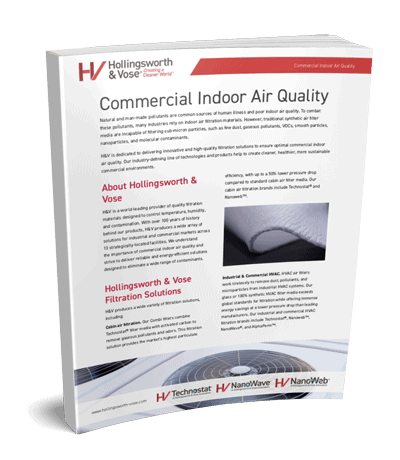
Indoor air pollution remains one of the leading environmental health problems the world faces today. Indoor pollutant concentrations are often as much as five times higher than those outdoors, and with humans spending over 80% of their time inside buildings, the health risks are significant. In addition to causing general discomfort, certain pollutants can lead to respiratory and cardiovascular diseases that develop after long-term exposure and can also negatively impact occupant productivity, manufacturing processes, and product quality. NanoWave® filter media provides an ideal solution for use in HVAC filters to mitigate the effects of air pollution and provide enhanced indoor air quality (IAQ).
What is NanoWave® ?
NanoWave® is a patented extended-surface synthetic filter media that protects environments from hazardous levels of air pollution while significantly reducing energy consumption in commercial, industrial, and residential facilities. This allows for increased efficiency and effectiveness of HVAC systems in all types of locations.
What are the specific benefits of NanoWave® air quality filtration?
NanoWave® empowers optimal filtration performance, offering extremely low pressure drop to high dust-holding capacity and consistent efficiency compared to conventional synthetic and glass mat media. When fabricated into finished filters, NanoWave technology allows our customers to meet and exceed international filter performance standards ISO 16890 and ASHRAE 52.2.
Featuring mechanical filtration that ensures consistent filtering efficiency, NanoWave’s patented design reduces pressure drop by as much as 40% compared to other types of premium filtration media. This allows for NanoWave-equipped filters to achieve the highest energy ratings of A and A+ in accordance with the new 2019 Eurovent Energy Efficiency Rating for the European market.
Using NanoWave filter media in HVAC systems dramatically improves air quality through the reduction of exposure to fine particles, dust, and allergens. This solution also cuts down on energy costs without negatively impacting the environment. Energy used in the building sector accounts for more than 20% of total energy consumption globally, and HVAC equipment contributes 40% of that energy usage in commercial buildings. By implementing NanoWave, you can decrease energy burdens and gain carbon savings to support not only healthier buildings but a healthier planet.
Why is indoor air quality (IAQ) so important?
Indoor air pollution is a major public health threat globally. Both man-made and natural pollutants cause poor indoor air quality and illness, including dust particles, fine particulate matter, volatile organic compounds (VOCs), and mold. To mitigate these pollutants, a wide range of industries turn to reliable indoor air filtration solutions.
Data shows that indoor air pollution contributes to millions of premature deaths, and air pollution remains a serious problem in workplaces as it puts employees, manufacturing processes, and products at risk of illness, reduced productivity, and contamination. The use of NanoWave media for HVAC systems can protect air against dangerous levels of contamination.
What does the future hold for filtration solutions using NanoWave?
The expanding public awareness regarding the need for improved air quality and general sustainability will continue to amplify growth opportunities for the filtration market. For example, the growing trend of healthier buildings using WELL and LEED standards and other certifications will likely continue and increase public demand.
One way to unlock more opportunities in synthetic media composites is to design individual filter media layers into a more versatile, advanced composite media. The home HVAC space, for example, is making major strides in this area. As HEPA filtration levels become increasingly attributable to long-term health, innovations in filter media will likely impact public buildings, schools, homes and other structures.
NanoWave® filter media comes in three different performance levels across a range of filtration efficiencies based on the needs of each application. Connect with us to find the right solution for your products.
What applications can NanoWave® be utilized in?
We design our NanoWave® filter media products to increase the efficacy and efficiency of HVAC systems in the built environment. This media is easy to process, safe to install in any location, and results in no damage to manufacturing equipment. It also benefits the environment by using fully and safely disposable materials.
Some specific applications for NanoWave® include:
Commercial and Residential Buildings
NanoWave® filter media works with various HVAC system filter configurations, whether installed in office buildings, hospitals, medical centers, data centers, schools and universities, restaurants, shopping malls, hotels, airports, retail outlets, warehouses, or apartment buildings and multifamily homes.
Industrial Applications
Our customers use NanoWave® filter media for many industrial facilities, including food and beverage production, pharmaceutical manufacturing, electronics production, cleanrooms, labs, steel mills, paint spray booths, warehouses, welding facilities, power plants, and other types of plants.
Why should you choose Hollingsworth & Vose NanoWave® filter media solutions?
Our NanoWave® synthetic filtration solution is a prime example of Hollingsworth & Vose’s dedication to providing a cleaner and more sustainable environment for everyone. Filters that use NanoWave technology can remove air pollutants with more efficiency. This allows for cleaner and fresher air in all types of buildings while cutting down on energy consumption.
Improving indoor air quality with efficiency is what drives us, and we continuously invest in the development of filtration technologies to achieve this goal. For more information about our NanoWave filter media and to find the ideal solution for your application, contact us today. You can also view our latest brochure on Commercial Indoor Air Quality below!







